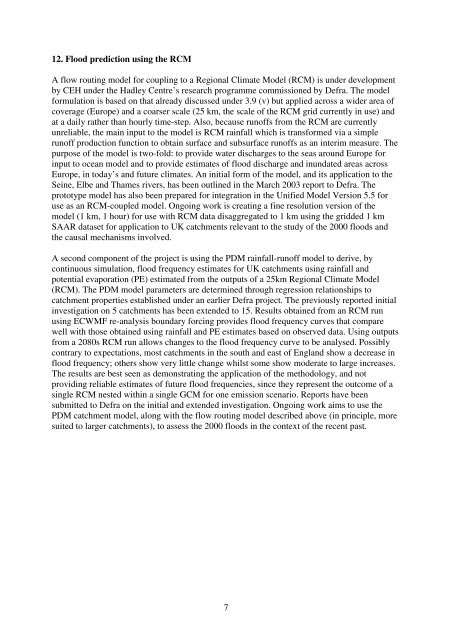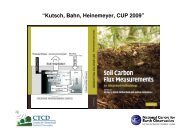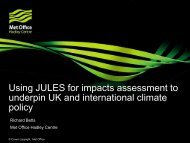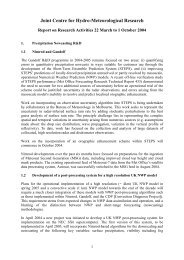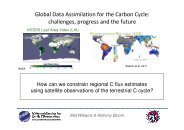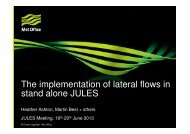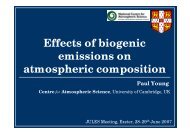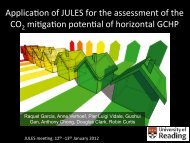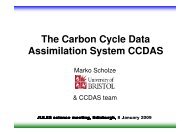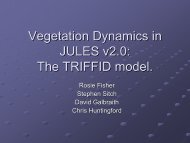here in PDF format - Joint Centre for Hydro-Meteorological Research
here in PDF format - Joint Centre for Hydro-Meteorological Research
here in PDF format - Joint Centre for Hydro-Meteorological Research
You also want an ePaper? Increase the reach of your titles
YUMPU automatically turns print PDFs into web optimized ePapers that Google loves.
12. Flood prediction us<strong>in</strong>g the RCM<br />
A flow rout<strong>in</strong>g model <strong>for</strong> coupl<strong>in</strong>g to a Regional Climate Model (RCM) is under development<br />
by CEH under the Hadley <strong>Centre</strong>’s research programme commissioned by Defra. The model<br />
<strong>for</strong>mulation is based on that already discussed under 3.9 (v) but applied across a wider area of<br />
coverage (Europe) and a coarser scale (25 km, the scale of the RCM grid currently <strong>in</strong> use) and<br />
at a daily rather than hourly time-step. Also, because runoffs from the RCM are currently<br />
unreliable, the ma<strong>in</strong> <strong>in</strong>put to the model is RCM ra<strong>in</strong>fall which is trans<strong>for</strong>med via a simple<br />
runoff production function to obta<strong>in</strong> surface and subsurface runoffs as an <strong>in</strong>terim measure. The<br />
purpose of the model is two-fold: to provide water discharges to the seas around Europe <strong>for</strong><br />
<strong>in</strong>put to ocean model and to provide estimates of flood discharge and <strong>in</strong>undated areas across<br />
Europe, <strong>in</strong> today’s and future climates. An <strong>in</strong>itial <strong>for</strong>m of the model, and its application to the<br />
Se<strong>in</strong>e, Elbe and Thames rivers, has been outl<strong>in</strong>ed <strong>in</strong> the March 2003 report to Defra. The<br />
prototype model has also been prepared <strong>for</strong> <strong>in</strong>tegration <strong>in</strong> the Unified Model Version 5.5 <strong>for</strong><br />
use as an RCM-coupled model. Ongo<strong>in</strong>g work is creat<strong>in</strong>g a f<strong>in</strong>e resolution version of the<br />
model (1 km, 1 hour) <strong>for</strong> use with RCM data disaggregated to 1 km us<strong>in</strong>g the gridded 1 km<br />
SAAR dataset <strong>for</strong> application to UK catchments relevant to the study of the 2000 floods and<br />
the causal mechanisms <strong>in</strong>volved.<br />
A second component of the project is us<strong>in</strong>g the PDM ra<strong>in</strong>fall-runoff model to derive, by<br />
cont<strong>in</strong>uous simulation, flood frequency estimates <strong>for</strong> UK catchments us<strong>in</strong>g ra<strong>in</strong>fall and<br />
potential evaporation (PE) estimated from the outputs of a 25km Regional Climate Model<br />
(RCM). The PDM model parameters are determ<strong>in</strong>ed through regression relationships to<br />
catchment properties established under an earlier Defra project. The previously reported <strong>in</strong>itial<br />
<strong>in</strong>vestigation on 5 catchments has been extended to 15. Results obta<strong>in</strong>ed from an RCM run<br />
us<strong>in</strong>g ECWMF re-analysis boundary <strong>for</strong>c<strong>in</strong>g provides flood frequency curves that compare<br />
well with those obta<strong>in</strong>ed us<strong>in</strong>g ra<strong>in</strong>fall and PE estimates based on observed data. Us<strong>in</strong>g outputs<br />
from a 2080s RCM run allows changes to the flood frequency curve to be analysed. Possibly<br />
contrary to expectations, most catchments <strong>in</strong> the south and east of England show a decrease <strong>in</strong><br />
flood frequency; others show very little change whilst some show moderate to large <strong>in</strong>creases.<br />
The results are best seen as demonstrat<strong>in</strong>g the application of the methodology, and not<br />
provid<strong>in</strong>g reliable estimates of future flood frequencies, s<strong>in</strong>ce they represent the outcome of a<br />
s<strong>in</strong>gle RCM nested with<strong>in</strong> a s<strong>in</strong>gle GCM <strong>for</strong> one emission scenario. Reports have been<br />
submitted to Defra on the <strong>in</strong>itial and extended <strong>in</strong>vestigation. Ongo<strong>in</strong>g work aims to use the<br />
PDM catchment model, along with the flow rout<strong>in</strong>g model described above (<strong>in</strong> pr<strong>in</strong>ciple, more<br />
suited to larger catchments), to assess the 2000 floods <strong>in</strong> the context of the recent past.<br />
7


